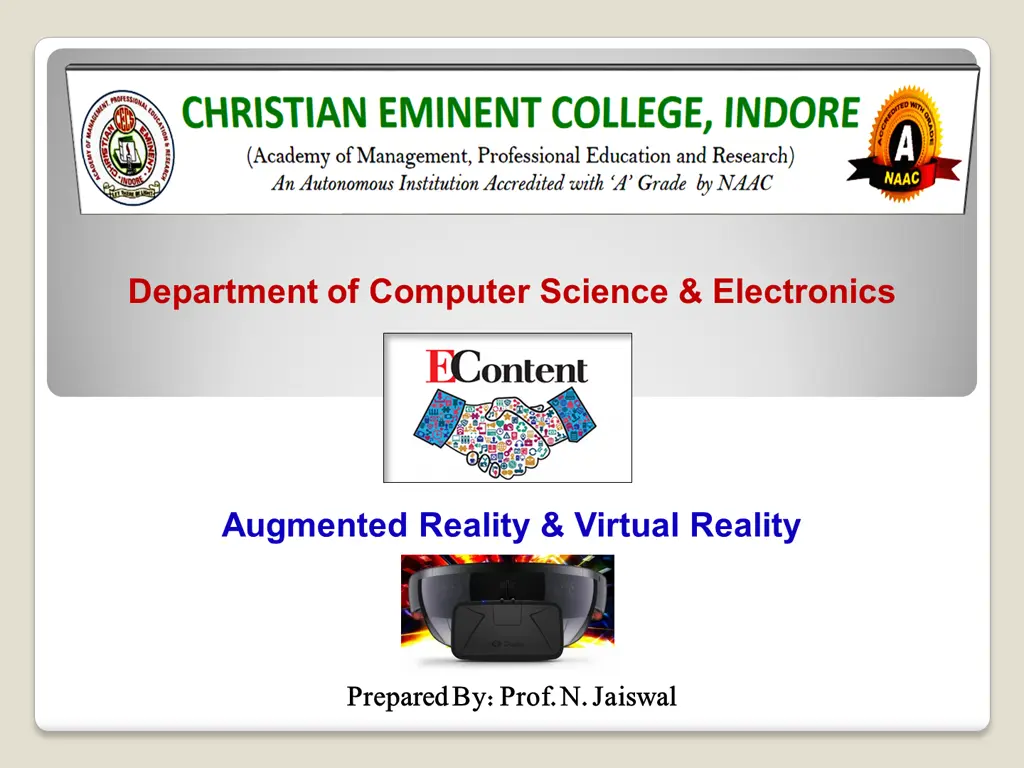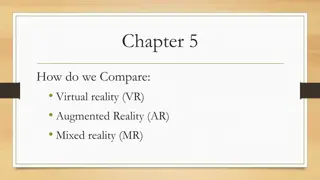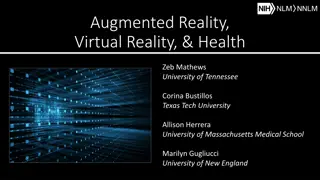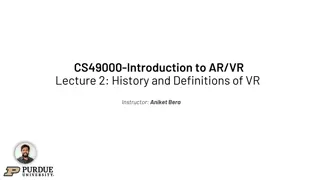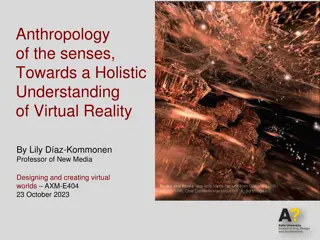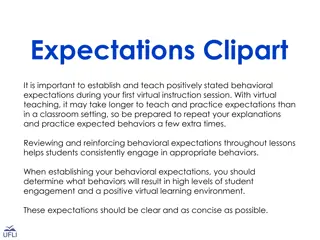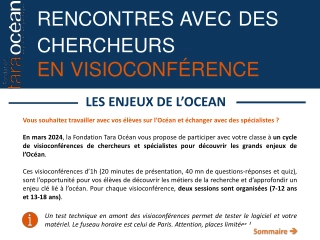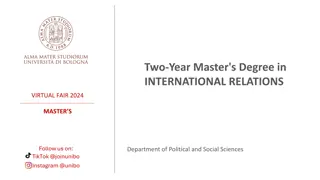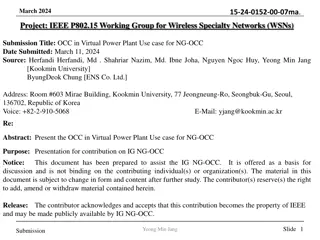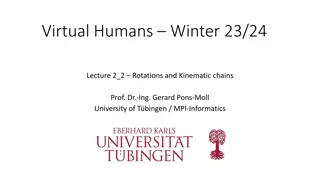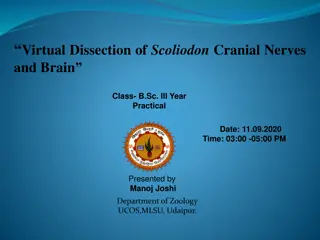Augmented Reality & Virtual Reality
The concepts and applications of augmented reality and virtual reality in the Department of Computer Science & Electronics. Discover the benefits and limitations of these technologies.
- augmented reality
- virtual reality
- computer science
- electronics
- innovation
- interactive experience
- education
- technology
Download Presentation

Please find below an Image/Link to download the presentation.
The content on the website is provided AS IS for your information and personal use only. It may not be sold, licensed, or shared on other websites without obtaining consent from the author. Download presentation by click this link. If you encounter any issues during the download, it is possible that the publisher has removed the file from their server.
E N D
Presentation Transcript
Department of Computer Science & Electronics Augmented Reality & Virtual Reality Prepared By: Prof. N. Jaiswal Prepared By: Prof. N. Jaiswal
Augmented Reality The word "Augmented" means to add. It is created by using the technology by adding digital information to an image or something. Augmented reality is an important concept and impacts our lives deeply. It provides an improved version of reality as it uses different tools to make the environment existing and real. Augmented reality gives you an interactive experience of the real-world environment. It keeps you in your place and superimposes the technology in the form of text, sounds, and images. Augmented reality merges the physical world with computer-generated virtual elements. It is accessed using common equipment such as mobile phones. There are nearly uncountable possibilities with the Augmented Reality. With the smartphone's camera, AR adds the digital elements to a live view. It uses the smartphone's camera to present the real world's view in front of us and then put a layer of information that includes the text or images on the top of that view. Some of the examples of Augmented Reality are the Pokemon Go game, Snapchat lenses.
Now, let's see the benefits and limitations of augmented reality. Advantages of Augmented Reality It increases accuracy. It offers innovation, continuous improvement, and individualized learning. It helps developers to build games that offer real experiences. It enhances the knowledge and information of the user. Disadvantages of Augmented Reality The limitations of Augmented Reality are listed as follows - Projects based on AR technology are expensive to implement and develop. Excessive use of augmented reality technology can lead to eye problems, obesity, etc. It can cause mental health issues
Virtual Reality It is a very important and interesting term. The terms 'Virtual refers to something conceptual that does not have its physical existence, and the word 'reality refers to the state of being real. So, virtual reality means something that is almost real. It is defined as the creation of a simulated environment by using computer technology. Viewing virtual reality means viewing a completely different reality than the one in front of you. It can be artificial, like an animated scene or a place which is photographed and integrated in a virtual reality app. It enables us to move around and look in every direction - up, down, sideways, and behind, as we are present there actually. Virtual reality apps allow us to explore the places that we have never been to, such as the Mars surface, the top of Mt. Everest, areas deep under the sea, and many more things that we can imagine only. It uses three of our senses: hearing, touching, seeing, to trick the brain into thinking that we are at a different place.
Advantages of Virtual Reality It creates an interactive environment. It helps us to explore the world by creating a realistic world using computer technology. It makes education comfortable and easy. It allows users to do an experiment in an artificial environment. It increases the work capabilities. Virtual reality is helpful for medical students to do practice well. It will be helpful for patients, too, as it offers a safe environment to them by which a patient can come into contact with the things they fear. Virtual reality helps to measure the performance of sportsperson and analyze their techniques.
Disadvantages of Virtual Reality Using VR, people start ignoring the real world. They started living in the virtual world instead of dealing with the issues of the real world. Training in the virtual environment does not have the same result as training in the actual world. It is not guaranteed that a person has done a task well in the real world if he/she has performed that task well in the virtual world.
Augmented Reality v/s Virtual Reality Now, let's see the comparison chart betweenAugmented reality and Virtual reality. Augmented Reality (AR) The system augments the real-world scene In AR User always have a sense of presence in the real world AR is 25% virtual and 75% real This technology partially immerses the user into the action Virtual Reality (VR) Completely immersive virtual environment In VR, visual senses are under control of the system VR is 75% virtual and 25% real This technology fully immerses the user into the action AR requires upwards of 100 Mbps bandwidth VR requires at least a 50 Mbps connection No AR headset is needed. With AR, end-users are still in touch with the real world while interacting with virtual objects nearer to them. It is used to enhance both real and virtual worlds. Some VR headset device is needed. By using VR technology, VR user is isolated from the real world and immerses himself in a completely fictional world. It is used to enhance fictional reality for the gaming world.
On the basis of Augmented Reality Virtual Reality Involvement In AR user is partially immersed with the real world, i.e. user is immersed with mix of real-world and virtual world. In VR, the user is completely immersed in a virtual world. Distinction In augmented reality, it is easy to distinguish between both real-world and virtual world. In Virtual reality, it is hard to distinguish between the virtual world and real world. Devices used In AR, there is a use of tablet, smartphones, or another mobile device. In VR, there is a use of head-mounted display or glasses. Reality and virtuality Augmented reality is 75% real and 25% virtual. Virtual reality is 75% virtual and 25% real. Network data Augmented reality requires upwards of 100Mbps bandwidth. A virtual reality video with 720p requires a connection of atleast 50Mbps. Revenue The projected revenue share for augmented reality in 2020 is $120 million. The projected revenue share for virtual reality in 2020 is $30 million. Visual senses In Augmented reality, a user always has a sense of presence in the real world. Whereas, in virtual reality, the visual senses are under control of the system.
Mixed reality is the next wave in computing followed by mainframes, PCs, and smartphones. Mixed reality is going mainstream for consumers and businesses. It liberates us from screen-bound experiences by offering instinctual interactions with data in our living spaces and with our friends. Online explorers, in hundreds of millions around the world, have experienced mixed reality through their handheld devices. Mobile AR offers the most mainstream mixed reality solutions today on social media. People may not even realize that the AR filters they use on Instagram are mixed reality experiences. Windows Mixed Reality takes all these user experiences to the next level with stunning holographic representations of people, high fidelity holographic 3D models, and the real world around them.
Extended reality (XR) is an umbrella term that encompasses any sort of technology that alters reality by adding digital elements to the physical or real-world environment by any extent, blurring the line between the XR includes AR, MR, VR, and any technology even those that have yet to be developed situated at any point of the virtuality continuum. physical and the digital world.
The Rise Of Technology-Augmented Reality(AR), Virtual Reality(VR) And Mixed Reality(MR) https://www.youtube.com/watch?v=XLP4YTpUpBI
